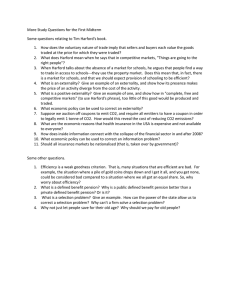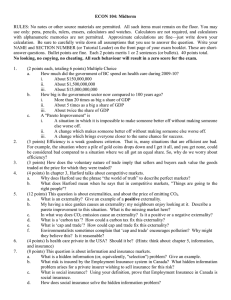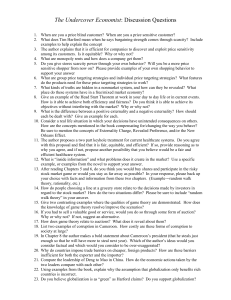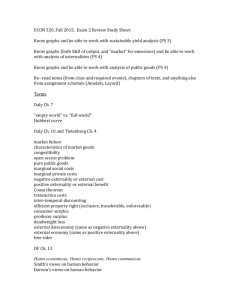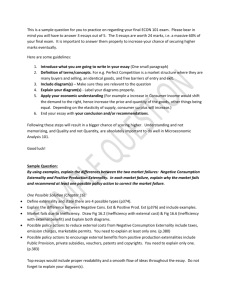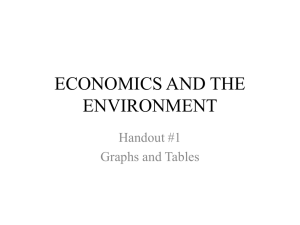ECON 104: Midterm 1. (2 points each, totaling 6 points) Multiple Choice
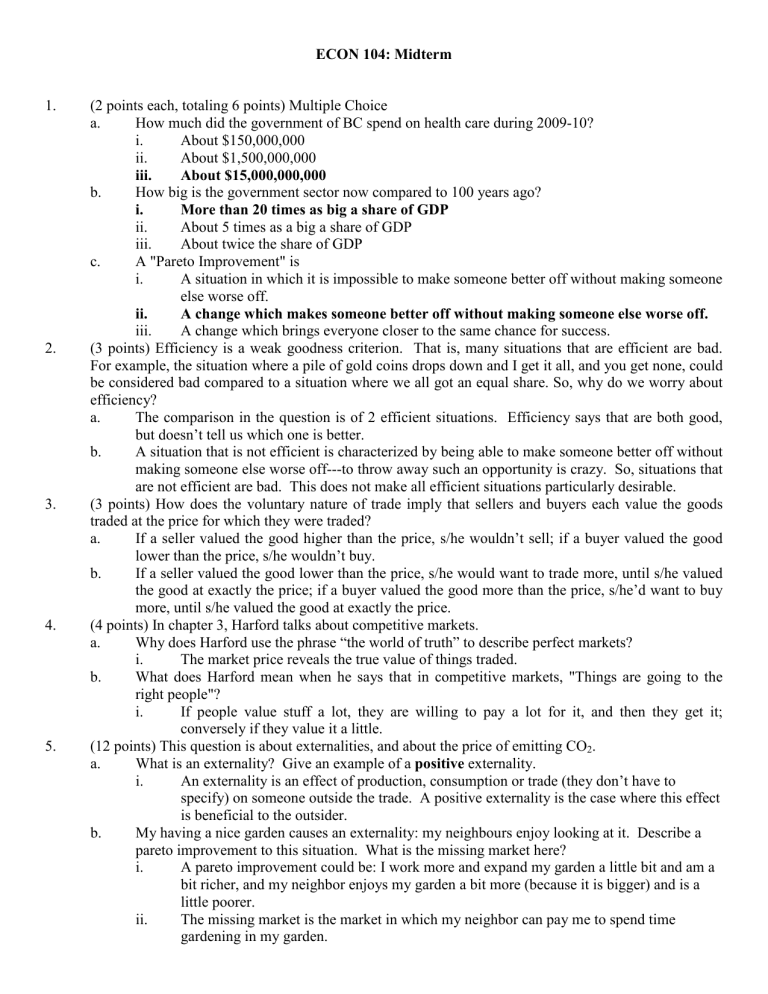
1.
2.
3.
4.
5.
ECON 104: Midterm
(2 points each, totaling 6 points) Multiple Choice a.
How much did the government of BC spend on health care during 2009-10? i.
ii.
About $150,000,000
About $1,500,000,000 b.
c.
iii.
About $15,000,000,000
How big is the government sector now compared to 100 years ago? i.
ii.
More than 20 times as big a share of GDP
About 5 times as a big a share of GDP iii.
About twice the share of GDP
A "Pareto Improvement" is i.
A situation in which it is impossible to make someone better off without making someone else worse off. ii.
A change which makes someone better off without making someone else worse off. iii.
A change which brings everyone closer to the same chance for success.
(3 points) Efficiency is a weak goodness criterion. That is, many situations that are efficient are bad.
For example, the situation where a pile of gold coins drops down and I get it all, and you get none, could be considered bad compared to a situation where we all got an equal share. So, why do we worry about efficiency? a.
The comparison in the question is of 2 efficient situations. Efficiency says that are both good, but doesn’t tell us which one is better. b.
A situation that is not efficient is characterized by being able to make someone better off without making someone else worse off---to throw away such an opportunity is crazy. So, situations that are not efficient are bad. This does not make all efficient situations particularly desirable.
(3 points) How does the voluntary nature of trade imply that sellers and buyers each value the goods traded at the price for which they were traded? a.
If a seller valued the good higher than the price, s/he wouldn’t sell; if a buyer valued the good lower than the price, s/he wouldn’t buy. b.
If a seller valued the good lower than the price, s/he would want to trade more, until s/he valued the good at exactly the price; if a buyer valued the good more than the price, s/he’d want to buy more, until s/he valued the good at exactly the price.
(4 points) In chapter 3, Harford talks about competitive markets. a.
Why does Harford use the phrase “the world of truth” to describe perfect markets? b.
i.
The market price reveals the true value of things traded.
What does Harford mean when he says that in competitive markets, "Things are going to the right people"? i.
If people value stuff a lot, they are willing to pay a lot for it, and then they get it; conversely if they value it a little.
(12 points) This question is about externalities, and about the price of emitting CO
2
. a.
What is an externality? Give an example of a positive externality. i.
An externality is an effect of production, consumption or trade (they don’t have to specify) on someone outside the trade. A positive externality is the case where this effect b.
is beneficial to the outsider.
My having a nice garden causes an externality: my neighbours enjoy looking at it. Describe a pareto improvement to this situation. What is the missing market here? i.
A pareto improvement could be: I work more and expand my garden a little bit and am a ii.
bit richer, and my neighbor enjoys my garden a bit more (because it is bigger) and is a little poorer.
The missing market is the market in which my neighbor can pay me to spend time gardening in my garden.
6.
7.
c.
d.
e.
In what way does CO
2
emission cause an externality? Is it a positive or a negative externality? i.
It raises the global temperature. For most people, this is a negative externality, because they are exposed to hotter weather that is worse for agriculture and sea levels rise and flood them. (For some, it is positive, because it makes, e.g., northern Canada warmer and nicer.)
What is a ‘carbon tax’? How could a carbon tax fix this externality? i.
A carbon tax is a tax paid when one emits CO
2
. In practice, it is levied on goods that emit CO
2
when they are used, like gasoline. It raises the price of emission up from zero, and so discourages emission.
What is ‘cap and trade’? How could cap and trade fix this externality? i.
The government sets a cap on total emissions and issues coupons that people and/or firms need in order to emit (e.g., a tonne) of CO
2
. The coupons are tradeable, and would trade for a positive price. This would raise the price of emission up from zero, and so discourage emission. f.
Environmentalists sometimes complain that ‘cap and trade’ encourages pollution? Why might they believe this? Is it reasonable? i.
The government sets a cap, and so in some sense ‘guarantees’ a level of total emission.
In that sense, they encourage CO
2
pollution, because there won’t be less than the cap.
(4 points) Is health care private in the USA? Should it be? (Hints: think about: chapter 5, information, and insurance) a.
Canada and the USA spend the same fraction of GDP on publicly funded health care---7% or so. b.
c.
d.
This is just under half of US total health spending.
Health insurers face a hidden information (selection) problem, and compete for the lowest risk clients. High risk clients lie about their riskiness, thus raising the price of insuring all people.
Any reference to relevant stuff in chapter 5 should get them something.
They should answer whether it should or should not be private, and defend with anything relevant about information, insurance and/or chapter 5.
(8 points) This question is about information and insurance markets. a.
What is a hidden information (or, equivalently, "selection") problem? Give an example. i.
Something relevant to the value of the traded good is known by one trader and not the other, and is important to the ignorant trader. It is a problem because they ignorant trader b.
c.
d.
doesn’t know the information, and the informed trader knows but has an incentive to lie about it. Any example will do.
What risk is insured by the Employment Insurance system in Canada? What hidden information problem arises for a private insurer wishing to sell insurance for this risk? i.
ii.
Risk of job loss
Different people have different risks of job loss, which they know, but won’t want to tell, for fear of facing a high insurance premium.
What is social insurance? Using your definition, prove that Employment Insurance in Canada is social insurance. i.
ii.
Mandatory public monopolist single-policy insurance.
You have to buy EI, you buy it from the state, you can’t buy it from anyone else, and there is no choice of what to buy.
How does social insurance solve the hidden information problem? i.
The insurer doesn’t have to worry about you lying because it doesn’t need the information about any individual person. It charges the same premium to everyone
(single policy), and they don’t have the choice to opt out (mandatory) or choose another supplier (monopolist).
